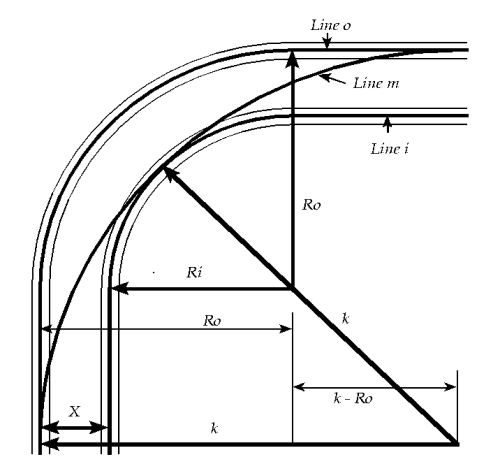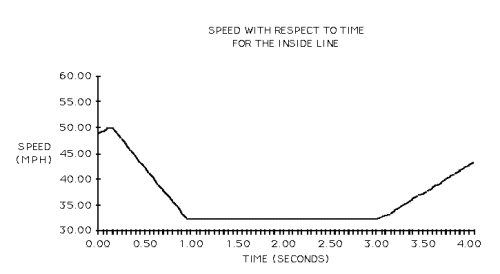|
|
|
5 - Introduction to the Racing Line Last Updated: 11/22/2010 |
|||||||||||||||||||||||||||||||||||||||||||||||||||||||||||||||||||||||||||||||||||||||||||||
|
This month, we analyse the best way to go through a corner. "Best" means in the least time, at the greatest average speed. We ask "what is the shape of the driving line through the corner that gives the best time?" and "what are the times for some other lines, say hugging the outside or the inside of the corner?" Given the answers to these questions, we go on to ask "what shape does a corner have to be before the driving line I choose doesn't make any time difference?" The answer is a little surprising.
The analysis presented here is the simplest I could come up with, and yet is still quite complicated. My calculations went through about thirty steps before I got the answer. Don't worry, I won't drag you through the mathematics; I just sketch out the analysis, trying to focus on the basic principles. Anyone who would read through thirty formulas would probably just as soon derive them for him or herself.
There are several simplifying assumptions I make to get through the analysis. First of all, I consider the corner in isolation; as an abstract entity lifted out of the rest of a course. The actual best driving line through a corner depends on what comes before it and after it. You usually want to optimise exit speed if the corner leads onto a straight. You might not apex if another corner is coming up. You may be forced into an unfavourable entrance by a prior curve or slalom.
Speaking of road courses, you will hear drivers say things like "you have to do such-and-such in turn six to be on line for turn ten and the front straight." In other words, actions in any one spot carry consequences pretty much all the way around. The ultimate drivers figure out the line for the entire course and drive it as a unit, taking a Zen-like approach. When learning, it is probably best to start out optimising each kind of corner in isolation, then work up to combinations of two corners, three corners, and so on. In my own driving, there are certain kinds of three corner combinations I know, but mostly I work in twos. I have a long way to go.
It is not feasible to analyse an actual course in an exact, mathematical way. In other words, although science can provide general principles and hints, finding the line is, in practice, an art. For me, it is one of the most fun parts of racing.
Other simplifying assumptions I make are that the car can either accelerate, brake, or corner at constant speed, with abrupt transitions between behaviours. Thus, the lines I analyse are splices of accelerating, braking, and cornering phases. A real car can, must, and should do these things in combination and with smooth transitions between phases. It is, in fact, possible to do an exact, mathematical analysis with a more realistic car that transitions smoothly, but it is much more difficult than the splice-type analysis and does not provide enough more quantitative insight to justify its extra complexity for this article.
Our corner is the following ninety-degree right-hander:
This figure actually represents a family of corners with any constant width, any radius, and short straights before and after. First, we go through the entire analysis with a particular corner of 75 foot radius and 30 foot width, then we end up with times for corners of various radii and widths.
Let us define the following parameters: Now, when we drive this corner, we must keep the tyres on the course, otherwise we get a lot of cone penalties (or go into the weeds). It is easiest (though not so realistic) to do the analysis considering the path of the centre of gravity of the car rather than the paths of each wheel. So, we define an effective course, narrower than the real course, down which we may drive the centre of the car. This course is indicated by the labels and the thick radius lines in the figure.
From last month's article, we know that for a fixed centripetal acceleration, the maximum driving speed increases as the square root of the radius. So, if we drive the largest possible circle through the effective corner, starting at the outside of the entrance straight, going all the way to the inside in the middle of the corner (the apex), and ending up at the outside of the exit straight, we can corner at the maximum speed. Such a line is shown in the figure as the thick circle labelled "line m." This is a simplified version of the classic racing line through the corner. Line m reaches the apex at the geometrical centre of the circle, whereas the classic racing line reaches an apex after the geometrical centre - a late apex - because it assumes we are accelerating out of the corner and must therefore have a continuously increasing radius in the second half and a slightly tighter radius in the first half to prepare for the acceleration. But, we continue analysing the geometrically perfect line because it is relatively easy. The figure shows also Line i, the inside line, which come up the inside of the entrance straight, corners on the inside, and goes down the inside of the exit straight; and Line o, the outside line, which comes up the outside, corners on the outside, and exits on the outside.
One might argue that there are certain advantages of line i over line m. Line i is considerably shorter than Line m, and although we have to go slower through the corner part, we have less total distance to cover and might get through faster. Also, we can accelerate on part of the entrance chute and all the way on the exit chute, while we have to drive line m at constant speed. Let's find out how much time it takes to get through lines i and m. We include line o for completeness, even though it looks bad because it is both slower and longer than m.
If we assume a maximum centripetal acceleration of 1.10g, which is just within the capability of autocross tyres, we get the following speeds for the cornering phases of Lines i, o, and m: Line m is all cornering, so we can easily calculate the time to drive it once we know the radius, labelled k in the figure. A geometrical analysis results in
k = 3.414(Ro - 0.707Ri) = 145 feet and the time is For line i, we accelerate for a bit, brake until we reach 32.16 mph, corner at that speed, and then accelerate on the exit. Let's assume, to keep the comparison fair, that we have timing lights at the beginning and end of line m and that we can begin driving line i at 48.78 mph, the same speed that we can drive line m. Let us also assume that the car can accelerate at ˝g and brake at 1g. Our driving plan for line i results in the following velocity profile:
Because we can begin by accelerating, we start beating line m a little. We have to brake hard to make the corner. Finally, although we accelerate on the exit, we don't quite come up to 48.78 mph, the exit speed for line m. But, we don't care about exit speed, only time through the corner. Using the velocity profile above, we can calculate the time for line i, call it ti, to be 4.08 seconds. Line i loses by 9/10ths of a second. It is a fair margin to lose an autocross by this much over a whole course, but this analysis shows we can lose it in just one typical corner! In this case, line i is a catastrophic mistake. Incidentally, line o takes 4.24 seconds = to.
What if the corner were tighter or of greater radius? The following table shows some times for 30 foot wide corners of various radii: Line i never beats line m even though that as the radius increases, the margin of loss decreases. The trend is intuitive because corners of greater radius are also longer and the extra speed in line m over line i is less. The margin is greatest for tight corners because the width is a greater fraction of the length and the speed differential is greater.
How about for various widths? The following table shows times for a 75 foot radius corner of several widths: The wider the course, the greater the margin of loss. This is, again, intuitive since on a wide course, line m is a really large circle through even a very tight corner. Note that line o becomes better than line i for wide courses. This is because the speed differential between lines o and i is very great for wide courses. The most notable fact is that line m beats line i by 0.16 seconds even on a course that is only four feet wider than the car! You really must "use up the whole course."
So, the answer is, under the assumptions made, that the inside line is never better than the classic racing line. For the splice-type car behaviour assumed, I conjecture that no line is faster than line m.
We have gone through a simplified kind of variational analysis. Variational analysis is used in all branches of physics, especially mechanics and optics. It is possible, in fact, to express all theories of physics, even the most arcane, in variational form, and many physicists find this form very appealing. It is also possible to use variational analysis to write a computer program that finds an approximately perfect line through a complete, realistic course. ©Copyright 1991-2000 Brian Beckman Tags:
The Physics of Racing
|
|||||||||||||||||||||||||||||||||||||||||||||||||||||||||||||||||||||||||||||||||||||||||||||




